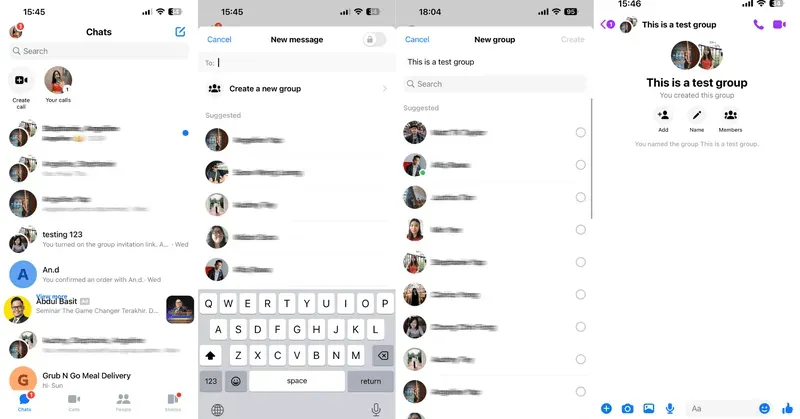Group chats have become a cornerstone of digital communication, offering a unique blend of connection and chaos in our increasingly busy lives. They serve as virtual hangouts where friendships can flourish amidst the challenges of distance and adult responsibilities. However, the importance of friendships is often tested as these conversations flood our phones, leaving some feeling overwhelmed by messages. While these platforms can help combat loneliness and technology’s isolating effects, they don’t replace the deeper, face-to-face interactions we crave. Understanding how to maintain connections in this digital age is vital, and navigating these group dynamics is a skill that can enhance our social lives.
In today’s fast-paced world, social groups often convene in virtual spaces rather than traditional settings—this is where online chatrooms and messaging apps come into play. These platforms provide a backdrop for sharing life updates, laughter, and support, yet they also raise questions about our interactions and emotional well-being. As we adapt to this modern form of engagement, the challenge lies in ensuring that our relationships remain resilient despite the barriers of screens and text. By exploring alternatives to casual chats, such as more personal interactions, we can revitalize our connections, fostering authentic friendships that go beyond mere digital presence.
The Importance of Maintaining Friendships in the Digital Age
In a world increasingly dominated by digital communication, the importance of friendships can’t be overstated. Adult life brings with it a myriad of responsibilities, making it challenging to cultivate close relationships as we once did in our youth. While group chats and messaging platforms keep us connected, they often create an illusion of intimacy without the depth of personal interaction. As loneliness becomes more prevalent—drawn out by geographical distances and hectic schedules—maintaining friendships requires more conscious effort than simply sending a text or reacting to a meme.
Studies reveal that while we may be communicating more than ever through technology, genuine connections are dwindling. The emotional needs that friends fulfill—support, understanding, companionship—often cannot be met through screens alone. This highlights a pressing need to balance the convenience of online communications with the nuances of face-to-face interaction. As friendships evolve in this digital landscape, we must be intentional about ensuring our connections are nurtured beyond group chats, through real-life interactions that help sustain the bonds we cherish.
Group Chats: A Double-Edged Sword in Today’s Communication
Group chats seem like a perfect solution for maintaining multiple friendships at once, yet they come with their own set of challenges. On one hand, they offer a platform for sharing moments and updates, like birthday greetings and exciting life changes, that help bridge the gap created by physical distance. However, many users report feeling overwhelmed by the flood of notifications and messages, which can turn the joy of connection into an obligation. In fact, 66% of adults feel they are inundated by messages, further complicating the perception that group chats sustain our social lives.
Meanwhile, the varied communication styles within group chats can lead to misunderstandings and emotional disconnects. Each friend may prioritize different forms of engagement, from those who prefer emojis to those seeking deeper conversations. This diversity can create a clash in expectations, where some members may feel left out or unheard. Ultimately, while group chats can serve as a casual means of staying in touch, they cannot fully replace meaningful, in-person friendships. Recognizing and addressing these limitations is essential for navigating our complex social lives.
Loneliness and Technology: A Paradox in Modern Relationships
As we delve into the relationship between loneliness and technology, it becomes clear that digital communication is a double-edged sword. On one hand, technology provides a platform for connection that can reduce feelings of isolation and keep us tethered to friends who might live far away. Yet, paradoxically, over-reliance on these tools can foster deeper feelings of loneliness. Engaging in group chats may feel like a substitute for actual friendship; however, without the physical presence that nurtures real connections, we may find ourselves feeling more disconnected than ever.
Research has increasingly highlighted the links between excessive screen time and heightened feelings of loneliness. While our devices keep us updated on friends’ lives, they cannot replicate the warmth of a shared laugh in person or the emotional comfort found in a face-to-face conversation. It’s vital for our mental health to analyze how these digital tools shape our relationships, ensuring that they enhance rather than detract from the meaningful connections we cherish.
Overwhelmed by Messages: The Mental Toll of Group Chats
The feeling of being overwhelmed by messages is becoming a common experience in today’s fast-paced digital communication landscape. Statistics indicate that a significant number of individuals—42% in one study—reported that keeping up with messages from group chats can feel like a part-time job. This burden not only affects our social lives but can also lead to increased stress and anxiety, threatening the very friendships that these platforms are designed to support. It is crucial to recognize the mental toll that constant notifications and expectations can impose.
In this context, it becomes vital to establish boundaries around our digital communications. Taking breaks from group chats, muting notifications, or even temporarily stepping back can provide necessary relief. Engaging in open conversations with friends about our preferences and limits can foster more understanding connections. A healthy friendship acknowledges these digital pressures, allowing for flexibility in communication that prioritizes mental wellness alongside maintaining connections.
Reassessing Digital Communication: Beyond Group Chats
Restructuring our approach to digital communication is essential in ensuring that friendships do not stagnate in the realm of group chats. While these chat spaces may serve as an avenue for social engagement, they risk reducing the quality of our interactions if relied upon solely. To attain a balanced friendship, it is important to complement group chats with one-on-one discussions and quality time spent together in person. By planning regular meet-ups or casual catch-ups, we can reinstate the vibrant, meaningful experiences that are often absent in group chat conversations.
Additionally, individuals can evaluate their personal usage habits and preferences. Understanding when to initiate face-to-face interactions over a quick text can strengthen bonds and provide a more fulfilling friendship experience. By inviting friends to step off the digital platform and into real-life encounters, we take active steps toward cultivating deeper connections, ultimately enriching our relationships and combating feelings of loneliness.
Friendship in a Post-Pandemic World: Prioritizing Real Connections
The pandemic has profoundly influenced how we perceive friendship and connection, highlighting the limitations of digital communication. As we navigate a post-pandemic world, there is a collective understanding of the need to prioritize meaningful interactions. People are gravitating toward spending time in person, recognizing the value of shared experiences and the emotional richness that comes from face-to-face contact. The once-familiar outline of friendship has shifted, and it is imperative to adapt to these changes by being proactive about maintaining our interpersonal relationships.
Moreover, the lessons learned during times of isolation should inform how we approach our friendships going forward. Putting effort into seeing friends and investing time in activities that foster connection can counteract the more superficial nature of interactions that often occur through screens. By turning our focus back to authenticity in relationships, we can deepen connections and redress the balance between digital and in-person exchanges, ensuring friendships thrive in this evolving landscape.
Nurturing Bonds: Strategies to Strengthen Friendships
To truly nurture bonds of friendship, we need to employ varied strategies that transcend the limitations of digital communication. One effective approach is to schedule regular check-ins with friends—these don’t have to involve elaborate plans but can simply include spontaneous phone calls or casual coffee dates. Prioritizing these interactions signifies to friends that they matter, helping to foster a deeper sense of belonging and emotional support. Simple gestures can often have a profound impact on the overall health of a friendship.
Engaging in shared activities that bring joy or common interests, whether it be group hikes, video game nights, or cooking classes, can also strengthen friendships. These experiences provide a platform for creating lasting memories that digital conversations often can’t replicate. It’s essential for friends to actively seek out these moments, ensuring that technology enhances rather than replaces the richness of genuine connection.
Embracing Vulnerability: The Key to Deepening Connections
To deepen friendships and move beyond the barriers often imposed by group chats, embracing vulnerability is essential. Sharing personal struggles or experiences—things that may feel daunting to disclose in a group setting—requires courage but can forge stronger, more authentic connections. This authentic sharing cultivates trust and emotional intimacy, allowing friendships to flourish, even in an era where casual exchanges abound. By being open about our challenges, we invite friends to do the same, creating a safe space for mutual support.
Moreover, addressing difficult subjects with friends—such as mental health, job-related stress, or family dilemmas—should not be left solely for individual conversations. Acknowledging these matters within the framework of friendship fosters understanding and compassion, reinforcing the bond between friends. By prioritizing vulnerability in our interactions, we take proactive steps toward nurturing friendships that are resilient, supportive, and deeply fulfilling.
Navigating Adult Friendships: A Shared Responsibility
As adults, nurturing friendships becomes a shared responsibility among friends. Recognizing that life’s demands can often create a rift in how frequently we connect emphasizes the need for everyone involved to make the effort to reach out. This collective endeavor can involve being proactive in scheduling get-togethers, checking in on one another, and understanding when someone might be having a tough time. By fostering an environment where everyone feels inclined to be an active participant in the friendship, we build a sense of unity and commitment to maintain those connections.
Additionally, in adult friendships, it’s crucial to manage expectations concerning communication. Openly discussing preferences for how often to message or meet can alleviate feelings of guilt or inadequacy that may arise when attempting to keep up with group chats or sporadic digital communication. Ultimately, it’s about collaboration in friendship—acknowledging that every person brings unique needs and circumstances to the table. Navigating adult friendships with empathy can help bridge gaps created by time and distance, fortifying the bonds that matter most.
Frequently Asked Questions
What is the importance of friendships in group chats?
Group chats play a crucial role in maintaining friendships by providing a space for regular communication, sharing updates, and expressing support. Although they cannot replace in-person interactions, they help reduce feelings of loneliness and reinforce connections among friends, especially as geographical distances grow.
How do group chats influence digital communication among friends?
Group chats enhance digital communication by facilitating instant messaging, video calls, and sharing multimedia content. They allow friends to engage with one another consistently and foster a sense of community, while also addressing the challenges of staying connected in our fast-paced lives.
Can group chats help combat loneliness and technology-related disconnection?
Yes, group chats can be an effective tool to combat loneliness by connecting individuals with their friends and loved ones. They bridge the gap created by physical distance and offer a platform for social interaction, allowing people to feel more included in each other’s lives despite geographical barriers.
What are the challenges of managing overwhelming messages in group chats?
Managing overwhelming messages in group chats can be challenging, as many users report feeling like keeping up with messages is akin to a part-time job. The constant influx of notifications can lead to stress and fatigue, making it essential to establish boundaries and prioritize meaningful interactions over the number of conversations.
How can we maintain genuine connections despite the challenges of group chats?
To maintain genuine connections despite the limitations of group chats, it’s important to incorporate one-on-one interactions, such as phone calls or face-to-face meetings. Being proactive and making time for personal connections can help deepen relationships and counteract the superficiality that can arise from digital communication.
| Key Points | Details |
|---|---|
| The Role of Group Chats | Group chats keep friends connected despite geographical distances but often replace in-person interactions. |
| Illusion of Friendship | They create an illusion of closeness while actually being a shallow form of relationship. |
| Flaws of Group Chats | Group chats can be overwhelming and may not meet everyone’s emotional needs. |
| In-Person Communication | Difficult topics are often hard to discuss in group chats, such as job losses or break-ups. |
| Need for Balance | To strengthen friendships, incorporate one-on-one calls and face-to-face meetings. |
| Reflection on Personal Habits | Acknowledges that technology shouldn’t be the only way to maintain friendships. |
Summary
Group chats often serve as a primary link to friends, but they can’t replace real-life relationships. While they may keep us informed and feeling connected, they also create the illusion of closeness without the depth of true companionship. It’s essential for friends to prioritize personal connections and face-to-face interactions, allowing friendships to thrive in a more meaningful way. Embracing both digital communication and in-person encounters is crucial for nurturing lasting relationships. Let’s not forget the importance of effort and presence in friendship, beyond the screen.



